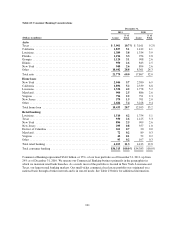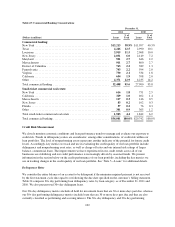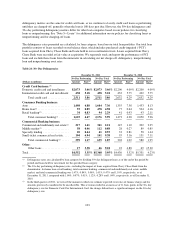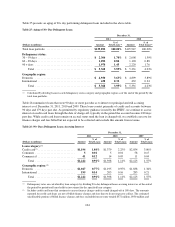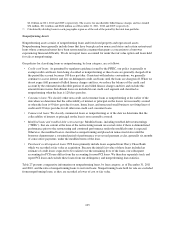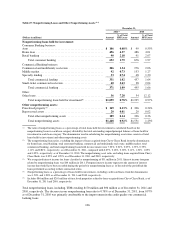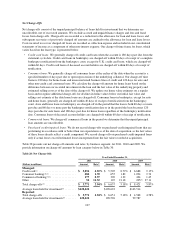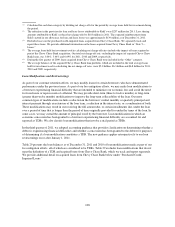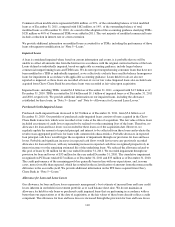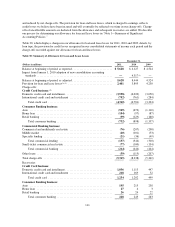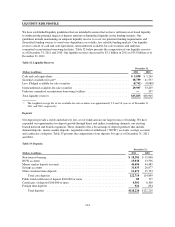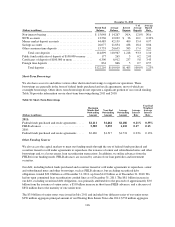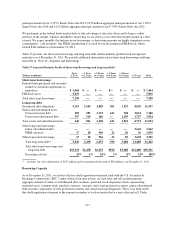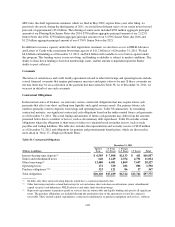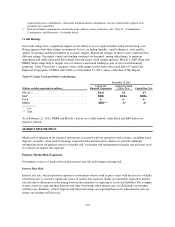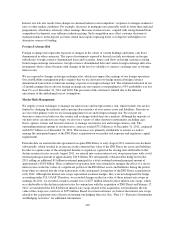Capital One 2011 Annual Report Download - page 130
Download and view the complete annual report
Please find page 130 of the 2011 Capital One annual report below. You can navigate through the pages in the report by either clicking on the pages listed below, or by using the keyword search tool below to find specific information within the annual report.Commercial loan modifications represented $426 million, or 27%, of the outstanding balance of total modified
loans as of December 31, 2011, compared with $162 million, or 14%, of the outstanding balance of total
modified loans as of December 31, 2010. As a result of the adoption of the accounting guidance clarifying TDRs,
$120 million or 40% of Commercial TDRs were added in 2011. The vast majority of modified commercial loans
include a reduction in interest rate or a term extension.
We provide additional information on modified loans accounted for as TDRs, including the performance of those
loans subsequent to modification, in “Note 5—Loans.”
Impaired Loans
A loan is considered impaired when, based on current information and events, it is probable that we will be
unable to collect all amounts due from the borrower in accordance with the original contractual terms of the loan.
Loans defined as individually impaired, based on applicable accounting guidance, include larger balance
commercial nonperforming loans and TDR loans. We do not report nonperforming consumer loans that have not
been modified in a TDR as individually impaired, as we collectively evaluate these smaller-balance homogenous
loans for impairment in accordance with applicable accounting guidance. Loans held for sale are also not
reported as impaired, as these loans are recorded at lower of cost or fair value. Impaired loans also exclude loans
acquired from Chevy Chase Bank because these loans were recorded at fair value upon acquisition.
Impaired loans, including TDRs, totaled $1.8 billion as of December 31, 2011, compared with $1.5 billion as of
December 31, 2010. TDRs accounted for $1.6 billion and $1.1 billion of impaired loans as of December 31, 2011
and 2010, respectively. We provide additional information on our impaired loans, including the allowance
established for these loans, in “Note 5—Loans” and “Note 6—Allowance for Loan and Lease Losses.”
Purchased Credit-Impaired Loans
Purchased credit-impaired loans decreased to $4.7 billion as of December 31, 2011, from $5.6 billion as of
December 31, 2010. Our portfolio of purchased credit-impaired loans consists of loans acquired in the Chevy
Chase Bank transaction, which were recorded at fair value at the date of acquisition. The fair value of these loans
included an estimate of credit losses expected to be realized over the remaining lives of the loans. Therefore, no
allowance for loan and lease losses was recorded for these loans as of the acquisition date. However, we
regularly update the amount of expected principal and interest to be collected from these loans and evaluate the
results on an aggregated pool basis for loans with common risk characteristics. Probable decreases in expected
loan principal cash flows would trigger the recognition of impairment through our provision for loan and lease
losses. Probable and significant increases in expected cash flows would first reverse any previously recorded
allowance for loan and losses, with any remaining increase in expected cash flows recognized prospectively in
interest income over the remaining estimated life of the underlying loans. We reduced the allowance related to
this pool of loans by $6 million for the year ended December 31, 2011. We recorded impairment through our
provision for loan and losses of $33 million for the year ended December 31, 2010. The cumulative impairment
recognized on PCI loans totaled $27 million as of December 31, 2011 and $33 million as of December 31, 2010.
The credit performance of the remaining pools has generally been in line with our expectations, and, in some
cases, more favorable than expected, which has resulted in the reclassification of amounts from the nonaccretable
difference to the accretable yield. We provide additional information on the PCI loans acquired from Chevy
Chase Bank in “Note 5—Loans.”
Allowance for Loan and Lease Losses
Our allowance for loan and lease losses represents management’s best estimate of incurred loan and lease credit
losses inherent in our held-for-investment portfolio as of each balance sheet date. We do not maintain an
allowance for held-for-sale loans or purchased-credit impaired loans that are performing in accordance with or
better than our expectations as of the date of acquisition, as the fair values of these loans already reflect a credit
component. The allowance for loan and lease losses is increased through the provision for loan and lease losses
110



